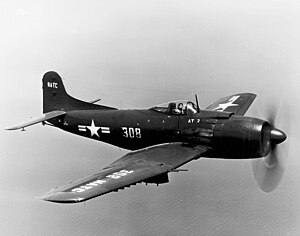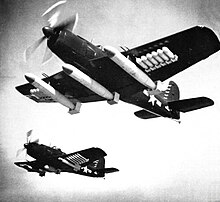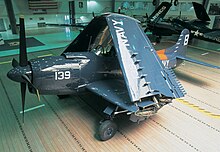This is an old revision of this page, as edited by MilborneOne (talk | contribs) at 15:07, 7 May 2011 (→References: add source). The present address (URL) is a permanent link to this revision, which may differ significantly from the current revision.
Revision as of 15:07, 7 May 2011 by MilborneOne (talk | contribs) (→References: add source)(diff) ← Previous revision | Latest revision (diff) | Newer revision → (diff)| AM (BTM) Mauler | |
|---|---|

| |
| An AM-1 of the U.S. Naval Test Center | |
| Role | Attack aircraftType of aircraft |
| National origin | United States |
| Manufacturer | Glenn L. Martin Company |
| First flight | 26 August 1944 |
| Introduction | March 1948 |
| Retired | 1953 |
| Primary user | United States Navy |
| Number built | 151 (including 18 AM-1Q and conversions) |
The Martin AM Mauler (originally BTM) was a shipboard attack aircraft of the United States Navy. Designed during World War II, the Mauler encountered production delays and did not enter service until March 1948. A total of 151 aircraft were built, remaining in front line service only until 1950, when the Navy standardized on the smaller and simpler Douglas AD Skyraider. Maulers remained in reserve squadrons until 1953. In service the Mauler earned the nickname "Able Mable" because of its remarkable load carrying ability, once lifting a 14,179 lb useful load, including 10,689 lbs of ordinance, easily the heaviest load ever carried by a single-engine piston-powered aircraft.
Design and development
In the 1930s and early 1940s, the Navy differentiated between two types of carrier-borne bomber: the torpedo bomber and the dive bomber. In 1943, this distinction was abandoned, and the US Navy invited proposals for a new multi-purpose bomber. In 1944, four new designs were offered as shipborne attack aircraft: the Curtiss XBTC-1/2, Douglas XBT2D-1, Kaiser-Fleetwings XBTK-1 and the Martin XBTM-1. Martin was tasked to provide a back-up to the Curtiss design which had been selected as a replacement to their SB2C Helldiver. Due to the US Navy's concern that the Curtiss design was overly complex and that the company's production record was particularly suspect in the Helldiver development phase, Martin was instructed to create an "unexperimental" design that would be a reliable platform for the Pratt & Whitney R-4360 Wasp Major that powered both aircraft. Two prototypes were ordered from Martin on 31 May 1944.

The first XBTM-1 flew on 26 August 1944, piloted by O.E. "Pat" Tibbs, Martin's Chief Test Pilot. The second prototype soon joined the fight test unit, followed up by 16 pre-production BTM Maulers. In 1946, the aircraft designation was changed to AM-1.
The AM-1Q was developed for electronic countermeasures (ECM) duties. The fuselage fuel tank was removed to make room for the ECM operator and his equipment. Twelve aircraft were built on the main production line.
Operational history

Delivery of Maulers began in July 1947, but problems with the tail hooks damaging the rear fuselage delayed service entry another year, and Mauler did not enter Navy service until March 1948, when Maulers began operating with VA-17A in the Atlantic Fleet. Maulers quickly gained a reputation as remarkable load lifters; on one occasion a Martin test pilot flew one hauling three 2,200 lb (1,000 kg) torpedoes, 12 500 lb (230 kg) bombs, guns, and a full load of ammunition — a total of 10,689 pounds (4,848 kg) of ordnance, and a 14,179 pounds (6,431 kg) useful load, a record at the time for a single-engine aircraft. Gross weight for that flight was 29,332 pounds (13,305 kg). Bomb loads in carrier service were smaller, and the aircraft gained a mostly-deserved reputation for being hard to land on carrier decks, leading to the nickname of "Awful Monsters". Pilots more favorably impressed by the bombload interpreted AM as "Able Mable".
With the prospect of flying both the similar AD-1 Skyraider and AM-1 in carrier operations, the US Navy assigned the Maulers to Atlantic Fleet squadrons. Although the Skyraider was a third smaller and carried a third less bombload, it proved much more reliable in service and easier to fly and land, and Navy pilots preferred it. In 1950, the decision was made to use the Mauler only from shore-based units and, later that year, all but Naval Reserve units abandoned the type. The aircraft continued to operate with reserve squadrons until 1953.

Variants
- XBTM-1
- Two prototypes built.
- BTM-1/AM-1
- A total of 132 production aircraft, another 651 aircraft were cancelled.
- AM-1Q
- A radar contermeasures variant, 17 aircraft built
Operators
- United States Navy
- VA-44, VA-45, VA-84, VA-85, VA-174, VC-4.
- Reserve attack squadrons at NAS Grosse Ile, NAS St. Louis, NAS Glenview, NAS Dallas, NAS Columbus, NAS Atlanta
Survivors

A number of survivors exist; the AM Mauler that set the payload record is preserved at the National Museum of Naval Aviation in Pensacola, Florida, while a number of less complete examples also survive.
- AM-1 BuNo 22257 - National Museum of Naval Aviation, Pensacola, Florida.
- AM-1 Glen L. Martin Maryland Aviation Museum, Maryland. This aircraft formerly belonged to the Commemorative Air Force (formerly the Confederate Air Force), and was kept in flying condition until the 1980s.
- AM-1 Tillamook Air Museum, Tillamook, Oregon
Specifications (AM-1 Mauler)

Data from American Combat Aircraft, Third Edition
General characteristics
- Crew: 1
Performance
Armament
See also
Aircraft of comparable role, configuration, and era
- A-1 Skyraider
- Blackburn Firebrand
- Curtiss XBTC
- Kaiser-Fleetwings XBTK
- TB2D Skypirate
- Blackburn Firecrest
Related lists
References
- Notes
- Footnotes
- Wagner 1982, p. 368
- Andrews and Boyne 1974, p. 8.
- Andrews and Boyne 1974, p. 9.
- ^ Swanborough and Bowers 1990, p. 358.
- ^ Andrews and Boyne 1974, p. 12.
- Kowalski 1995, p. 60.
- Wagner 1982, p. 368
- Wagner 1982, p. 368
- Wagner 1982, p. 368
- Wagner 1982, p. 368
- Wagner 1982, p. 368
- O'Rourke, G.G., CAPT USN. "Of Hosenoses, Stoofs, and Lefthanded Spads". United States Naval Institute Proceedings, July 1968.
- Wagner 1982, p. 368
- ^ Swanborough and Bowers 1990, p. 359.
- ^ Andrade 1979, p. 182
- Kowalski 1995, pp. 47–60.
- Kowalski 1995, pp. 61–71.
- "Martin AM-1 'Mauler': Aeroweb Mauler S/Ns" aero-web.org Aviation Enthusiast Corner, 2009. Retrieved: 19 July 2009.
- "The Mauler." Glen L. Martin Maryland Aviation Museum. Retrieved: 19 July 2009.
- "Aircraft List." Tillamook Air Museum. Retrieved: 19 July 2009.
- Wagner 1982, p. 368.
- Bibliography
- Andrade, John. U.S.Military Aircraft Designations and Serials since 1909, Midland Counties Publications, 1979, ISBN 0 904597 22 9
- Andrews, Hal and Walter Boyne. The Fable of Able Mable: Flying Fifteen Tons of Midnight Blue Beastie." Airpower, Vol. 4, Issue 4, July 1974.
- Green, William and Gerald Pollinger. The Aircraft of the World. London: Macdonald, 1955.
- Kowalski, Bob. Martin AM-1/1-Q Mauler. Simi Valley, CA: Ginter Books, 1995. ISBN 0-942612-24-8.
- Swanborough, Gordon and Peter M. Bowers. United States Navy Aircraft since 1911. London: Putnam Aeronautical Books, Third edition 1990. ISBN 0-85177-838-0.
- Wagner, Ray (1982). American Combat Planes, Third Edition. USA: Doubleday & Company. ISBN 0-385-13120-8.
- Wilson, Stewart. Combat Aircraft Since 1945. Fyshwick, Australia: Aerospace Publications Pty Ltd., 2000. ISBN 1-875671-50-1.
External links
| Martin and Martin Marietta aircraft | |
|---|---|
| Model numbers | |
| Airliners | |
| Attack aircraft | |
| Bombers | |
| Maritime patrol | |
| Military transports | |
| Military trainers | |
| Scout/Torpedo bombers | |
| Reconnaissance aircraft | |
| Observation aircraft | |
| Martin Marietta | |
| USN/USMC attack aircraft designations 1946–1962 by manufacturer | |
|---|---|
| Douglas | |
| Grumman | |
| McDonnell Douglas | |
| North American | |
| Martin | |
| Vought | |
| USN/USMC bomber designations 1931–1962 | |||||||||||||||
|---|---|---|---|---|---|---|---|---|---|---|---|---|---|---|---|
| Bomber |
| ||||||||||||||
| Bomber Drone |
| ||||||||||||||
| Bomber Fighter |
| ||||||||||||||
| Bomber Torpedo |
| ||||||||||||||
| Aviation lists | |
|---|---|
| General | |
| Military | |
| Accidents / incidents | |
| Records | |